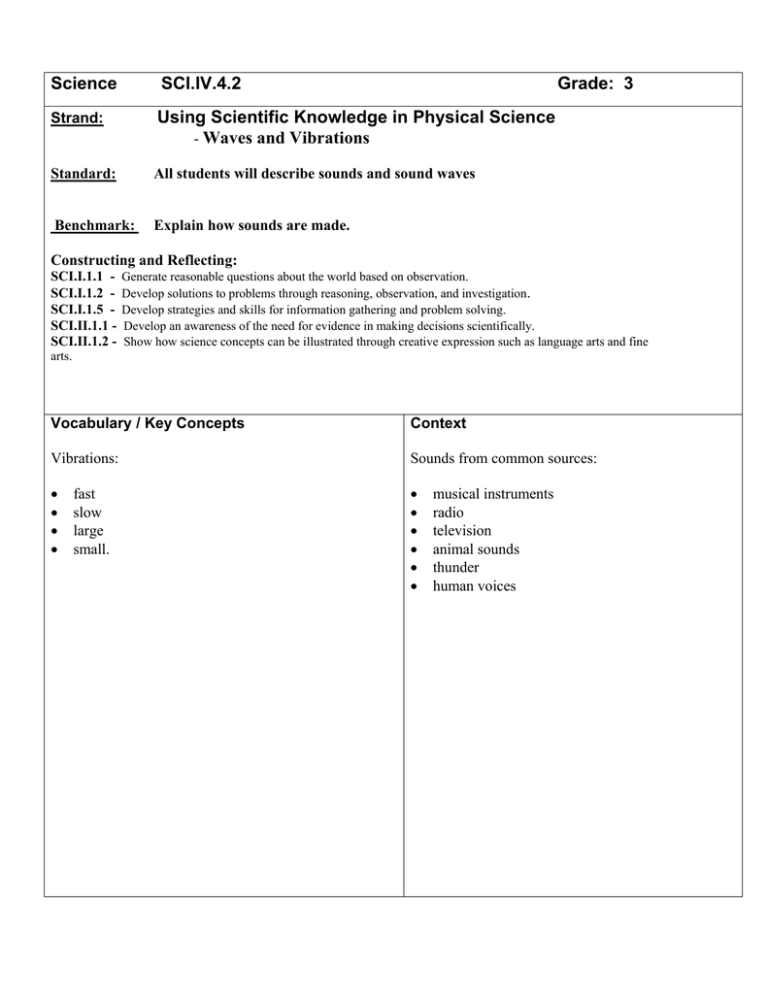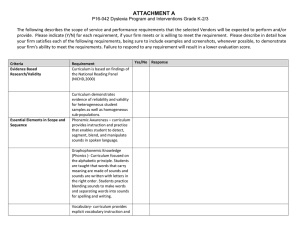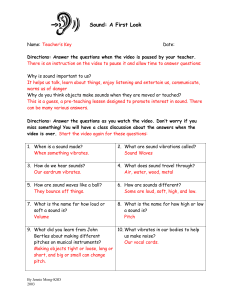Science SCI.IV.4.2
advertisement

Science SCI.IV.4.2 Grade: 3 Strand: Using Scientific Knowledge in Physical Science - Waves and Vibrations Standard: All students will describe sounds and sound waves Benchmark: Explain how sounds are made. Constructing and Reflecting: SCI.I.1.1 SCI.I.1.2 SCI.I.1.5 SCI.II.1.1 SCI.II.1.2 - Generate reasonable questions about the world based on observation. Develop solutions to problems through reasoning, observation, and investigation. Develop strategies and skills for information gathering and problem solving. Develop an awareness of the need for evidence in making decisions scientifically. Show how science concepts can be illustrated through creative expression such as language arts and fine arts. Vocabulary / Key Concepts Context Vibrations: Sounds from common sources: • • • • • • • • • • fast slow large small. musical instruments radio television animal sounds thunder human voices Knowledge and Skills Resources Coloma Resources: Students discover and explain that sound is caused by vibrating objects or substances. Discover the Wonder – Grade 3 Module E, pages 5-7 For example: • Tapping a pencil on a desk top • Feeling vocal cords while speaking • Striking a ruler held over the edge of a desktop • Tapping a tuning fork and putting it in a pan of water Other Resources: Gibson, Gary. Hearing Sounds. Copper Beach, 1995. Hewitt, Sally. Hearing Sounds. Children’s Press, 1999. Videoconferences Available For more information, see www.remc11.k12.mi.us/dl or call Janine Lim 471-7725x101 or email jlim@remc11.k12.mi.us 4.4.2 Sounds of Science from COSI Toledo (a science museum) Instruction Benchmark Question: How are sounds made? Focus Question: What causes sound? Teacher will instruct students to place their hand on their throat and make sounds. Class will discuss what they hear and feel focusing on vibration. Students will use common instruments to observe sound vibrations. • Tambourine • Guitar • Drum • Kazoo • Rattles Assessment It is recommend that the assessment for this Benchmark and Benchmark IV. 4. E. 2. be used for a culminating assessment for a sound unit. Students in groups will be part of a band. They will each construct an instrument. They will play a recognizable tune to an invited audience. Each student will identify their instrument and explain what it can do, demonstrating the volume and pitch. In the explanation, they will explain how different pitches can be made. After each student has described their instrument, the group will play their song. Presentations must include an explanation for: How is sound made? What is making the sound? Is it a fast or slow vibration? Why? Is it a big or small vibration? Why? Scoring Rubric Using a ruler, the students will hold the ruler over the edge of the desk. Tap it lightly. Listen and observe. Lengthen or shorten the amount of ruler hanging over the desk. Tap it lightly again. Listen and observe. What are the differences and the similarities in the sounds? Students should be able to observe the relationship between the length of the ruler, the pitch of the sound and the speed of the vibration. Repeat this activity several times with varying lengths. Criteria Apprentice Basic Meets Exceeds Effectiveness of construction Produce a musical sound without constructing an instrument Construct an instrument that produces a sound Construct an instrument that is capable of 2 different pitches Construct an instrument that is capable 3 or more pitches Accuracy of explanation Attempt to explain with misconceptions Explain how the instrument works using the concept of pitch or loudness Explain how instrument works using the concepts of pitch and loudness Explain how instrument works using the concepts of pitch and loudness plus explains sounds are produced through vibrations. Effectiveness of performance Attempt a tune Attempt a tune Perform a recognizable tune Performs a recognizable tune with movement Vibration explanation Identify where sound is coming from, but may not include “vibration”. Misconception between types of vibration and sound. Identify where sound is coming from including the word “vibration”. Student may have misconception between types of vibration and sounds Identify where sound is coming from including the word “vibration”. Explain the connection between big or small-fast or slow vibration. (one aspect of the explanation may be incorrect or missing) Identify where sound is coming from including the word “vibration”. Explain the connection between big or small-fast or slow vibration. (one aspect of the explanation may be incorrect or missing) and offers how the sound the instrument makes can be varied Teacher Notes: Describe sounds and sound waves. During the elementary grades, children should begin to describe and analyze their rich experiences with sounds. In particular, they should be able to distinguish sounds from the objects that make them. They need to understand that sounds exist in the air, and that they are separate from the objects that make them. Elementary students should learn that all sounds originate with some kind of vibrating object or substance. As middle school students experience sound traveling through different media; they should identify other ways that matter can affect sound. Many students think of echoes only as sounds that repeat themselves in open spaces. They do not relate them to the movement of sound waves, nor do they understand that echoes are produced whenever sound waves bounce back (reflect) off large surfaces.







